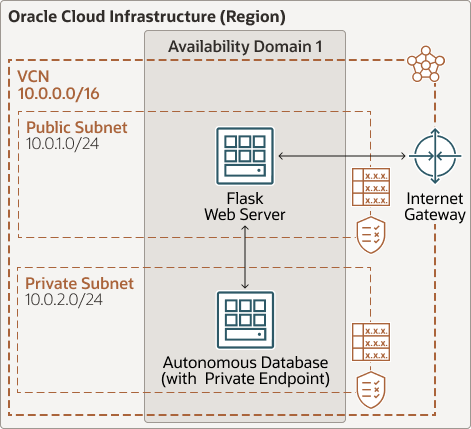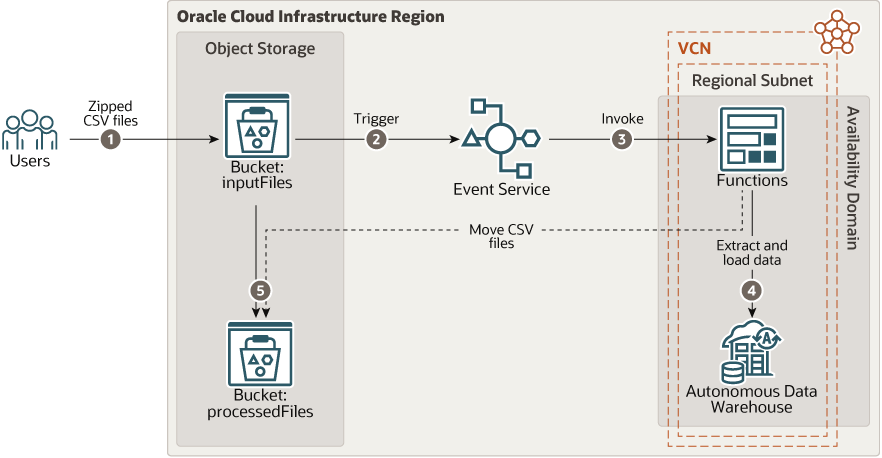Autonomous Data Warehouse
|

|
Oracle Autonomous Data Warehouse is Oracle's new, fully managed database tuned and optimized for data warehouse workloads with the market-leading performance of Oracle Database. It delivers a completely new, comprehensive cloud experience for data warehousing that is easy, fast, and elastic. |
Data Warehouse Reference Architecture Patterns
Open all Close allDepartmental Data Warehouse Pattern
A departmental data warehouse is used by individual teams or individual departments or groups and is intentionally limited in scope because it focuses on a clearly defined subset of data usually managed within a spreadsheet package.
Autonomous Database makes it easy to move departmental marts to a safe, secure always-on cloud...
Departmental Data Warehouse Customer Example
AoA Innovates Healthcare with Autonomous Database
|
|
AoA's benefited from zero maintenance, patching, or tuning database which freed up 6 financial and IT analysts. By using a modern data warehouse they were able to deliver real-time performance dashboards and reports for providers for more patient time. |
Where To Next...
Use the following topics to explore how you can get more from your Departmental Data Warehouse:
Discover How To Organize Your Data...
Discover New Ways to Analyze Your Data...
Learn How To Protect Your Sensitive Data...
Broaden The Scope Of Your Departmental Data Warehouse...
Departmental Data Warehouse From E-Business Suite
Analysts need an efficient way to consolidate data from multiple financial systems and other data sources into a trusted, maintainable, and query-optimized source.
Typically data mart projects struggle to optimize data from multiple sources which makes it very difficult to effectively analyze the data and generate actionable insights.
Autonomous Data Warehouse makes it easy to resolve these key challenges...
Departmental Data Warehouse Customer Example
DX Marketing innovates campaign management
|
|
Oracle Autonomous Data Warehouse helps DX Marketing integrate terabytes of 3rd-party data offline with online data in minutes with Oracle Analytics and Marketing Cloud for 14X revenue growth, reducing clients' customer acquisition costs by 52%. |
Where To Next...
Use the following topics to explore how you can get more from your Departmental Data Warehouse:
Discover How To Organize Your Data...
Discover New Ways to Analyze Your Data...
Learn How To Protect Your Sensitive Data...
Broaden The Scope Of Your Departmental Data Warehouse...
Departmental Data Warehouse For Human Capital
Human resource data is often distributed in multiple systems across the enterprise and can't easily be integrated and analyzed to produce actionable insights.
This makes it very difficult to capture raw application data, enrich it with data from other sources and produce actionable and predictive insights.
Autonomous Data Warehouse makes it easy to resolve these key challenges......
Where To Next...
Use the following topics to explore how you can get more from your Departmental Data Warehouse:
Discover How To Organize Your Data...
Discover New Ways to Analyze Your Data...
Learn How To Protect Your Sensitive Data...
Broaden The Scope Of Your Departmental Data Warehouse...
Enterprise Data Warehouse with Data Lakes
A modern data warehouse collects data from a wide variety of sources, both internal or external. The data is usually structured, often from relational databases, but it can be unstructured too pulled from "big data" sources such as Internet of Things devices etc.
Autonomous Data Warehouse makes it easy to integrate and secure data from many sources and then generate richer, smarter, faster business insights...
Departmental Data Warehouse Customer Example
OUTFRONT Media Innovates Sales with Autonomous Database,
|
|
OUTFRONT Media uses ADW and Analytics to ingest 1TB of external data in 30 minutes vs weeks with it's previous data warehouse. The business teams are benefiting from Autnomous Databases self-tuning features which has helped to reduce complex pricing queries to 6 minutes then to 2 seconds. |
Where To Next...
Use the following topics to explore how you can get more from your Departmental Data Warehouse:
Discover How To Organize Your Data...
Discover New Ways to Analyze Your Data...
Learn How To Protect Your Sensitive Data...
You can find more reference architectures patterns for Autonomous Data Warehouse...
Data Warehouse Solution Patterns
Open all Close allADW With Private Endpoints
This architecture uses an autonomous database (which can be an Oracle Autonomous Transaction Processing database or an Oracle Autonomous Data Warehouse) provisioned in a private subnet; that is with a private endpoint.
Building a Data Science Environment
This is a flexible architecture that can support multiple scenarios based on Oracle Machine Learning in Autonomous Data Warehouse. In addition to Autonomous Data Warehouse, it includes Data Catalog and Oracle Analytics Cloud along with three Oracle Cloud Infrastructure Compute instances.
Automated Data Loading in the Cloud
This reference architecture shows how you can use a serverless function to automate the process of extracting data from files generated by various databases or applications and loading the data into a data warehouse for analysis.
You can find more solution playbooks for Autonomous Data Warehouse...







